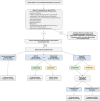Evaluating the Risk of Hypophosphatemia with Ferric Carboxymaltose and the Recommended Approaches for Management: A Consensus Statement
- PMID: 40725553
- PMCID: PMC12295483
- DOI: 10.3390/jcm14144861
Evaluating the Risk of Hypophosphatemia with Ferric Carboxymaltose and the Recommended Approaches for Management: A Consensus Statement
Abstract
Background/Objectives: The development of hypophosphatemia has been associated with intravenous iron products, with the rate of hypophosphatemia found to be higher with ferric carboxymaltose. This consensus statement provides clinical guidance on the risk of hypophosphatemia development with ferric carboxymaltose and the approaches for management. To develop consensus recommendations regarding the clinical implications of hypophosphatemia after the administration of ferric carboxymaltose, the assessment of patient risk profile, and recommended approaches for risk reduction. Methods: Consensus statements were developed from an in-person meeting of specialists with expertise in iron pathophysiology and iron therapy and further supplemented with literature review. The multidisciplinary expert panel comprised global iron specialists spanning anesthesiology, cardiology, gastroenterology, obstetrics/gynecology, hematology, nephrology, and iron molecular biology. Structured discussions were held in an in-person meeting to gather expert opinion on the evidence base regarding intravenous iron and hypophosphatemia. Consolidated summary opinions underwent further iterations of panel review to form consensus recommendation statements. Results: The expert panel developed the following consensus statements: (1) Routine serum phosphate level measurement is not recommended for low-risk patients before or after treatment with ferric carboxymaltose, as most cases of hypophosphatemia that occur following the administration of ferric carboxymaltose are asymptomatic and transient; (2) patients receiving ferric carboxymaltose should be assessed for the degree of risk for developing symptomatic or severe hypophosphatemia prior to administration; (3) monitoring serum phosphate is recommended for patients at an increased risk for developing low serum phosphate or who require repeated courses of ferric carboxymaltose treatment at higher doses; (4) prophylactic oral phosphorus after ferric carboxymaltose is unlikely to effectively elevate phosphate and is not recommended for routine clinical practice; and (5) hypophosphatemic osteomalacia is rare and the risk of development after the administration of ferric carboxymaltose, in particular single infusion, is low. Conclusions: Hypophosphatemia following ferric carboxymaltose is predominantly asymptomatic and transient. Individuals at higher risk for developing hypophosphatemia with ferric carboxymaltose treatment include those who receive multiple infusions, higher cumulative doses, or long-term iron treatment or who have underlying clinical risk factors. These consensus statements provide structured guidance on the risk of hypophosphatemia with ferric carboxymaltose and the approaches to clinical management.
Keywords: ferric carboxymaltose; hypophosphatemia; iron; iron deficiency anemia; phosphate.
Conflict of interest statement
G.R. has received honoraria and consulting fees from Alnylam, Astra Zeneca, Bayer, Boehringer Ingelheim, Cipla, CSL Vifor, Medronic, Servier, and Viatris. J.E. has received honoraria and grants from Amgen, Bayer, American Regent, Merck, Otsuka, Novo Nordisk, Applied Therapeutics, Cardurion, CSL Vifor, AstraZeneca, BI-Lilly, and US2.ai. E.N. has received consulting fees from Disc Medicine, Ionis Pharmaceuticals, Intrinsic Life Sciences, Chugai, CSL Vifor, and Novo Nordisk. P.P. has received honoraria and consulting fees from Boehringer Ingelheim, AstraZeneca, CSL Vifor, Servier, Novartis, Berlin Chemie, Bayer, Abbott Vascular, NovoNordisk, Pharmacosmos, WhiteSwell, Relaxera, and Radcliffe Group and has received research grants from CSL Vifor. M.R. has received honoraria from Alexion, CSL Vifor, and UCB. M.S. has received honoraria and/or research support from AMAG Pharmaceuticals, American Regent, Daiichi-Sankyo, Luitpold Pharmaceuticals, Pharmacosmos, and CSL Vifor; is a stockholder of AbbVie Inc., Abbott Laboratories, Bristol-Myers Squibb, Eli Lilly, Merck, and Pfizer; and is a stockholder and director of Periodic Products. D.R.S. has received honoraria and consulting fees from Alexion, AstraZeneca, Baxter, B. Braun Melsungen, CSL Behring, CSL Vifor, Celgene, Daiichi Sankyo, Haemonetics, iSEP, Novo Nordisk, Octapharma, Pharmacosmos, Pierre Fabre Pharma, Portola Schweiz, Roche Diagnostics, Shire, Werfen, and Zuellig. J.S. has received honoraria from AbbVie, CSL Vifor, Schär, Falk, Ferring, Fresenius Kabi, Immundiagnostik, Janssen, Medice, Pfizer, Pharmacosmos, Shield, Shire, Takeda, and Thermo Fisher and has board memberships with AbbVie, CSL Vifor Schär, Ferring, Fresenius Kabi, Immundiagnostik, Janssen, NPS Pharmaceuticals, Pharmacosmos, Shield, and Takeda. J.W. has received honoraria from Akebia, Calliditas, and CSL Vifor. R.J.M. has received honoraria and/or research support from American Regent, CSL Vifor, and Pharmacosmos.
Figures
Similar articles
-
Treatment of restless legs syndrome and periodic limb movement disorder: an American Academy of Sleep Medicine clinical practice guideline.J Clin Sleep Med. 2025 Jan 1;21(1):137-152. doi: 10.5664/jcsm.11390. J Clin Sleep Med. 2025. PMID: 39324694
-
Intravenous ferric carboxymaltose is associated with lowering of plasma phosphate levels in patients with gastric bypass surgery: a retrospective case series.Swiss Med Wkly. 2024 Jul 24;154:3771. doi: 10.57187/s.3771. Swiss Med Wkly. 2024. PMID: 39137372
-
Single-dose intravenous iron vs oral iron for treatment of maternal iron deficiency anemia: a randomized clinical trial.Am J Obstet Gynecol. 2025 Aug;233(2):120.e1-120.e18. doi: 10.1016/j.ajog.2025.01.037. Epub 2025 Feb 3. Am J Obstet Gynecol. 2025. PMID: 39909327 Clinical Trial.
-
EORTC guidelines for the use of erythropoietic proteins in anaemic patients with cancer: 2006 update.Eur J Cancer. 2007 Jan;43(2):258-70. doi: 10.1016/j.ejca.2006.10.014. Epub 2006 Dec 19. Eur J Cancer. 2007. PMID: 17182241
-
Home treatment for mental health problems: a systematic review.Health Technol Assess. 2001;5(15):1-139. doi: 10.3310/hta5150. Health Technol Assess. 2001. PMID: 11532236
References
Publication types
LinkOut - more resources
Full Text Sources


